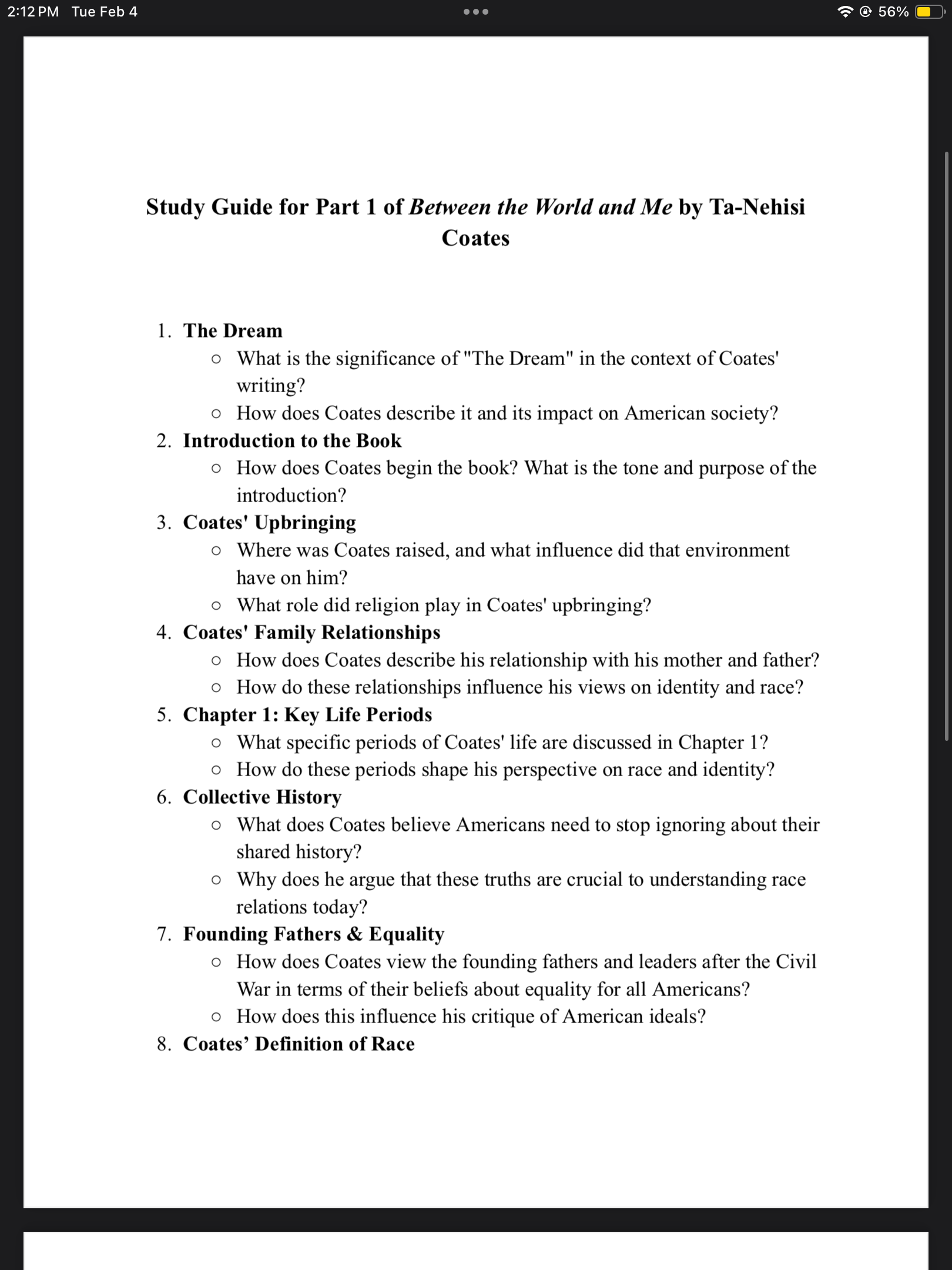What is the significance of 'The Dream' in the context of Coates' writing? How does Coates describe it and its impact on American society? How does Coates begin the book? What is t... What is the significance of 'The Dream' in the context of Coates' writing? How does Coates describe it and its impact on American society? How does Coates begin the book? What is the tone and purpose of the introduction? Where was Coates raised, and what influence did that environment have on him? What role did religion play in Coates' upbringing? How does Coates describe his relationship with his mother and father? How do these relationships influence his views on identity and race? What specific periods of Coates' life are discussed in Chapter 1? How do these periods shape his perspective on race and identity? What does Coates believe Americans need to stop ignoring about their shared history? Why does he argue these truths are crucial to understanding race relations today? How does Coates view the founding fathers and leaders after the Civil War in terms of their beliefs about equality for all Americans? How does this influence his critique of American ideals? How does Coates define race?

Understand the Problem
The question is asking for an analysis of various themes and concepts presented in Ta-Nehisi Coates' book, 'Between the World and Me.' It explores topics such as the significance of 'The Dream,' Coates' upbringing, family relationships, key life periods, collective history, views on equality, and the definition of race.
Answer
The Dream is idealized success rooted in inequality. Coates critiques its racial basis, explores identity from his Baltimore upbringing, critiques founding fathers’ equality beliefs, and demands historical acknowledgment for racial understanding.
The Dream in Coates' writing symbolizes the ideal of prosperity and success but is grounded in racial injustice. Coates sees it as an oppressive fantasy maintained by exploiting Black bodies. He begins the book with a direct and reflective tone, setting a critical context for exploring race. Coates grew up in Baltimore, influenced by racial realities, and his upbringing included secular influences counter to religious norms. His complex family relationships underscore his views on identity. Chapter 1 addresses key life periods like his childhood, shaping his perspective on race. Coates argues that Americans must acknowledge the historical truths of racial injustice to understand race today. He critiques the founding fathers for failing true equality. Race, to Coates, is a social construct rooted in history.
Answer for screen readers
The Dream in Coates' writing symbolizes the ideal of prosperity and success but is grounded in racial injustice. Coates sees it as an oppressive fantasy maintained by exploiting Black bodies. He begins the book with a direct and reflective tone, setting a critical context for exploring race. Coates grew up in Baltimore, influenced by racial realities, and his upbringing included secular influences counter to religious norms. His complex family relationships underscore his views on identity. Chapter 1 addresses key life periods like his childhood, shaping his perspective on race. Coates argues that Americans must acknowledge the historical truths of racial injustice to understand race today. He critiques the founding fathers for failing true equality. Race, to Coates, is a social construct rooted in history.
More Information
Coates uses 'The Dream' to critique systemic inequality and challenges readers to understand America's racial reality. His Baltimore upbringing and complex family dynamics shape his critical stance on race.
Tips
Readers often misinterpret 'The Dream' as a purely positive concept rather than acknowledging its racial implications. Understanding Coates' background is crucial for his perspective.
Sources
- The Dream Symbol in Between the World and Me - LitCharts - litcharts.com
- Between the World and Me Part I, pages 5-13 Summary & Analysis - sparknotes.com
- Between the World and Me by Coates | Themes, Summary & Analysis - study.com
AI-generated content may contain errors. Please verify critical information